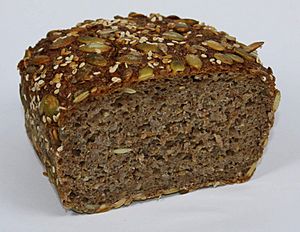Sprouted bread facts for kids

Vegan flourless sprouted wheat bread
|
|
| Type | Bread |
|---|---|
| Main ingredients | Whole grains (sprouted) |
Sprouted bread is a special kind of bread. It's made from whole grains that have started to sprout, or germinate. This means the grains begin to grow tiny shoots before they are ground into flour.
There are different types of sprouted grain bread. Some have extra flour added. Others, like Essene bread and Ezekiel bread, are made with very few extra ingredients. Ezekiel bread is named after an ancient recipe found in the Bible (Ezekiel 4:9).
Contents
What is Sprouted Bread?

Sprouted breads use the entire sprouted grain. This includes the whole kernel or "berry" of different seeds.
This is different from white bread. White bread is made only from the inner part of the wheat grain, called the endosperm. The outer layers, the bran and germ, are removed.
Whole grain breads keep all parts of the grain. This means they have more natural fiber, vitamins, and proteins. Sprouted grain breads have about the same amount of vitamins per gram as other whole grain breads.
Sprouted Grains: A Healthy Choice
Sprouted grain bread has less gluten than regular bread. About 47% less! This can be good for people who are sensitive to gluten.
When grains sprout, their nutrition changes. Sprouted grains have a bit less carbohydrates than whole grains that haven't sprouted. They also have slightly more protein and less fat.
Besides wheat, sprouted breads can include other grains and legumes. These might be millet, barley, oat, lentil, and soy.
A bread made from many different grains and legumes can give you all the amino acids you need. Amino acids are the building blocks of proteins. Sprouted breads might also have a little more trace minerals and nutrients.
Eating sprouted bread offers many of the same benefits as eating other whole grain breads. For example, it can help lower the risk of heart disease.
Essene Bread: An Ancient Recipe
Essene bread is a simple type of sprouted grain bread. It is made from sprouted wheat. It's often prepared at a low temperature.
People who follow a raw food diet often eat Essene bread uncooked or just slightly warmed.
The Essenes were an ancient Jewish group. They lived from about 200 BC to 100 AD. They are often given credit for the idea and basic recipes for Essene bread. However, there isn't strong historical proof for this claim.
Sprouting and cooking at low temperatures help keep as many vitamins as possible in the bread. Sprouting also breaks down certain substances, like lectins. Some people might be sensitive or allergic to these substances.
See also
 In Spanish: Pan esenio para niños
In Spanish: Pan esenio para niños


